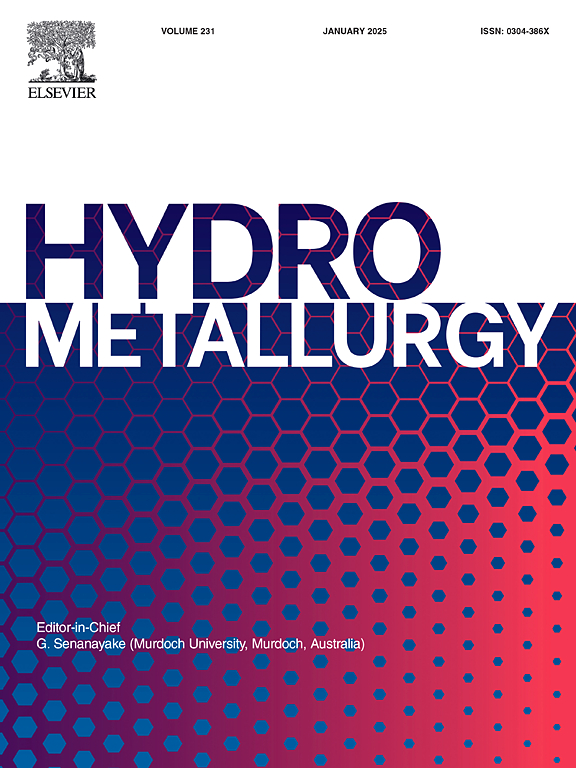含硫官能团改性树脂的制备及其在废合金渗滤液中的钨钼吸附分离性能
IF 4.8
2区 材料科学
Q1 METALLURGY & METALLURGICAL ENGINEERING
引用次数: 0
摘要
由于钨和钼是中国的战略金属,因此钨和钼二次资源的高效、清洁和增值利用是重要的。硫化后用树脂吸附Mo的离子交换方法可以有效地分离W和Mo,但这些方法会造成硫化物污染。本研究以叔胺基苯乙烯-二乙烯基苯共聚物为基体,采用分子式为C5H10O2S的乙酸乙酯(甲基硫代)对大孔阴离子交换树脂D301进行改性,得到树脂EA-D301。该树脂具有以下性能:(1)提高了W和Mo的吸附和分离效率;(2)具有致密的结构和发育良好的孔隙;(3)在pH为7.5、25°C、金属浓度为0.05 mol/L的WMo溶液中,W的最大吸附量(QW)为1062 mg/g;(4)最大分离因子(βMoW)为6.95。EA-D301对W和Mo的吸附几乎不受其他阴离子的影响,在10次吸附-解吸循环后,QW仍保持在908 mg/g以上,具有良好的稳定性。吸附机理为离子交换反应+配位反应。用EA-D301处理实际WMo废合金渗滤液,QW为647 mg/g, βMoW为4.03,具有较好的工业应用效果。EA-D301树脂具有合成简单、吸附量大、环境友好等优点,是一种很有前途的W吸附剂。该树脂为从各种资源中提取W和分离W、Mo提供了有效的途径。本文章由计算机程序翻译,如有差异,请以英文原文为准。
Preparation of sulfur-containing functional group-modified resin and its tungsten‑molybdenum adsorption and separation performance with application to waste-alloy leachate
Since W and Mo are strategic metals in China, the efficient, clean, and value-added utilization of secondary W and Mo resources is important. Ion-exchange methods using resins for the adsorption of Mo after sulfidation can effectively separate W and Mo, but these methods cause sulfide pollution. In this study, the macroporous anion exchange resin D301, which consists of a styrene-divinylbenzene copolymer matrix with tertiary amine groups, was modified by ethyl (methylthio) acetate (EA) of molecular formula C5H10O2S to form resin EA-D301. This resin has the following properties: (i) enhanced the efficiency of W and Mo adsorption and separation, (ii) exhibited a dense structure and well-developed pores, (iii) maximum adsorption capacity (QW) of 1062 mg/g for W, and (iv) maximum separation factor () of 6.95 at pH 7.5 and 25 °C in a W![]() Mo solution with equal metal concentrations of 0.05 mol/L. The adsorption of both W and Mo by EA-D301 was hardly affected by other anions, and QW remained as high as 908 mg/g after ten adsorption-desorption cycles, indicating good stability. The adsorption mechanism was an ion-exchange reaction followed by coordination reactions. When EA-D301 was used to treat actual W
Mo solution with equal metal concentrations of 0.05 mol/L. The adsorption of both W and Mo by EA-D301 was hardly affected by other anions, and QW remained as high as 908 mg/g after ten adsorption-desorption cycles, indicating good stability. The adsorption mechanism was an ion-exchange reaction followed by coordination reactions. When EA-D301 was used to treat actual W![]() Mo waste alloy leachate, a QW of 647 mg/g and a of 4.03 were achieved, demonstrating good performance in industrial applications. The EA-D301 resin is a promising W adsorbent with advantages such as simple synthesis, high adsorption capacity, and environmental friendliness. This resin provides an effective way to extract W and separate W and Mo from various resources.
Mo waste alloy leachate, a QW of 647 mg/g and a of 4.03 were achieved, demonstrating good performance in industrial applications. The EA-D301 resin is a promising W adsorbent with advantages such as simple synthesis, high adsorption capacity, and environmental friendliness. This resin provides an effective way to extract W and separate W and Mo from various resources.
求助全文
通过发布文献求助,成功后即可免费获取论文全文。
去求助
来源期刊

Hydrometallurgy
工程技术-冶金工程
CiteScore
9.50
自引率
6.40%
发文量
144
审稿时长
3.4 months
期刊介绍:
Hydrometallurgy aims to compile studies on novel processes, process design, chemistry, modelling, control, economics and interfaces between unit operations, and to provide a forum for discussions on case histories and operational difficulties.
Topics covered include: leaching of metal values by chemical reagents or bacterial action at ambient or elevated pressures and temperatures; separation of solids from leach liquors; removal of impurities and recovery of metal values by precipitation, ion exchange, solvent extraction, gaseous reduction, cementation, electro-winning and electro-refining; pre-treatment of ores by roasting or chemical treatments such as halogenation or reduction; recycling of reagents and treatment of effluents.
 求助内容:
求助内容: 应助结果提醒方式:
应助结果提醒方式:


